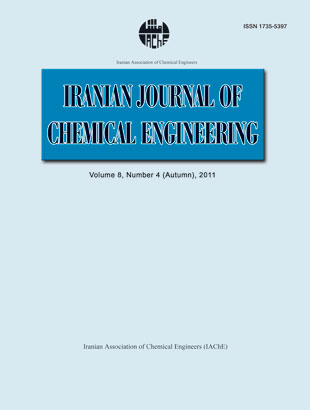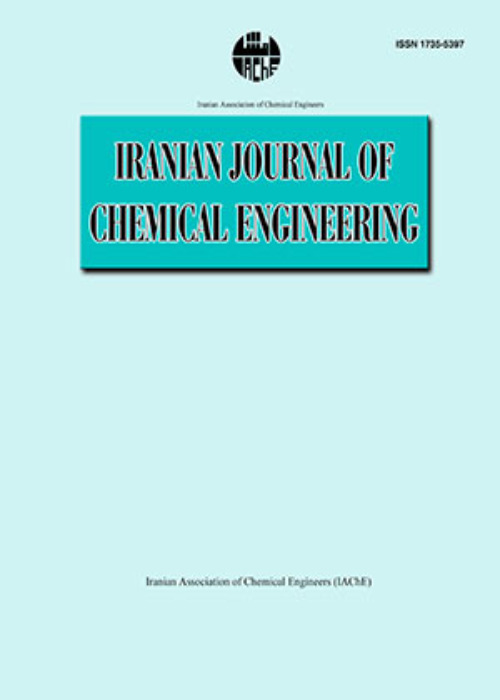فهرست مطالب

Iranian journal of chemical engineering
Volume:8 Issue: 4, Autumn2011
- تاریخ انتشار: 1390/12/10
- تعداد عناوین: 7
-
-
Pages 3-10Sauter mean drop sizes have been measured in a pulsed packed extraction column for two liquid systems with and without mass transfer conditions. The effects of pulsation intensity, phase flow rates, and interfacial tension on drop size have been investigated under a variety of operating conditions. The drop size is influenced mainly by pulsation intensity and interfacial tension. Significant, but weaker, are the effects of continuous and dispersed phase flow rates. A precise correlation is proposed for predicting mean drop size in terms of operating variables, physical properties of the liquid systems and mass transfer direction. Good agreement between prediction and experiments is found for all operating conditions that were investigated.
-
Pages 11-23Adsorption capacity of Cr(VI) onto activated carbon, almond and apricot shells was investigated in a batch system by considering the effects of various parameters like contact time, initial concentration, pH, temperature, agitation speed, absorbent dose and particle size.The adsorption was solution pH dependent and the maximum adsorption was observed at solution pH of 2.0. The amounts of Cr(VI) adsorbed increased with increase in dose of both adsorbents and their contact time. A contact time of 30 min was found to be optimum. Experimental results show low cost biosorbent was effective for the removal of pollutants from aqueous solution. The pseudo-second-order kinetic model gave a better fit of the experimental data compared to the pseudo-first-order kinetic model. Experimental data showed a good fit with the Freundlich isotherm model.
-
Pages 24-33The prepared mesoporous spherical alumina with high-surface area was employed as a support for nickel catalysts in methane decomposition reaction. It was observed that, the catalytic activity of Ni/Al2O3 catalysts was high at the initial times of reaction and decreased with time on stream, and finally reached a constant value. The deactivation rate of catalysts is dependent on the catalyst characteristics and the operating conditions. The activity results indicate that, the yield of hydrogen and the structure of deposited carbon are strongly dependent on the loading amount of Ni. The SEM results showed that carbon formed on the catalysts in the form of filamentous carbon. Concerning hydrogen production, the 10%Ni/ Al2O3 catalyst leads to a higher yield, due to the higher amount of active phases which can catalyze further the number of methane molecules, while lesser amounts of filamentous carbon were observed on this catalyst than for 5 and 7.5%Ni/ Al2O3 catalysts at the same operating condition. The yield of hydrogen and structure of filamentous carbon also significantly depend on the reaction temperatures and residence time of gas in the reactor, as the 10%Ni/ Al2O3 catalyst showed a remarkable stability with a decrease of about 14% at 800 °C and 25 ml/min after 240 min of reaction. The obtained results showed that the prepared Ni/ Al2O3 catalysts had a good activity in methane decomposition reaction, which is one of the highest activities among those for low nickel loaded catalysts reported up until now.
-
Pages 34-42Polyurea microcapsules containing an active agent, i.e. ethion as pesticide, have been prepared by interfacial polymerization between 2, 4-toluene diisocyanate (TDI) and diethylenetriamine (DETA) in an oil-in-water (O/W) emulsion system. The effects of the nature of the emulsifier, the monomer weight ratio, and a novel promoter, i.e. potassium phthalimide-N-oxyl (PPINO), on the morphology, microstructure, and thermal stability of the microcapsules have been investigated. PPINO was used as a water-soluble promoter capable of dimerizing and trimerizing the isocyanate reactant in the interfacial polymerization. The transmission electron microscopy (TEM) micrographs showed that the addition of the promoter had no significant effect on the microcapsule shell thickness. Increasing the amount of PPINO caused the degree of crystallinity of the polymer shell to decrease considerably. In addition, increasing the amount of promoter up to 2 wt% caused the thermal stability of the microcapsules to decrease, while using promoter beyond this level resulted in higher thermal stability.
-
Pages 43-49Migration of styrene monomer from polystyrene (PS) dishes was conducted during this research at temperatures of 5, 20, and 40C. According to the Food and Drug Administration (FDA) regulations, these experiments were performed in contact with 10%ethanol as a food simulant for the oil in water (o/w) emulsions. The dishes were filled in each of the defined temperatures and stored for 35 days. In relatively close intervals (1, 7, 15, 24, and 35 days) the amount of migration which occurred was determined by means of Head Space Gas Chromatography Mass Spectrometry (HS-GC-MS). By increasing storage time and temperature, the amount of migration was increased and in all times and temperatures styrene monomer was detected. In addition, a mathematical model based on the Fick’s second law was validated to predict migration from packaging material into the 10% ethanol. The resulted diffusion coefficients were 3.6×10-18, 4.9×10-18, and 6×10-18 (m2/s) in 5, 20 and 40C respectively.
-
Pages 50-56Chlorinated hydrocarbons and aromatics are the major volatile organic compounds that contaminate the ground water and industrial waste waters. The best way to overcome this problem is to recover the dissolved compounds in water. In order to evaluate the potential ability of granular activated carbon (GAC) for recovery of volatile organic compounds from water, the equilibrium adsorption was investigated. This study deals with the adsorption of dichloromethane as a typical chlorinated volatile organic compound (VOCs) and toluene as the representative of aromatic volatile organic compounds on a commercial GAC. The adsorption isotherms of these two volatile organic compounds on GAC were measured at three different temperatures, toluene at 293, 303 and 313 K and dichloromethane at 298, 303 and 313 K within their solubility concentration range in water. The maximum adsorption capacity of dichloromethane and toluene adsorption by GAC was 4 and 0.2 mol/Kg-1, respectively. The experimental data obtained were correlated with different adsorption isotherm models. The Langmuir model was well adapted to the description of dichloromethane adsorption on GAC at all three temperatures, while the adsorption of toluene on GAC was found to be well described by the Langmuir-BET hybrid model at all three temperatures. The heat of adsorption was also calculated based on the thermodynamic equation of Clausius–Clapeyron, which indicates the adsorption process is endothermic for both compounds.
-
Pages 57-64An experimental study of the phase inversion phenomenon was carried out in a rotating disc contactor (9.3 cm diameter). The effect of energy input via agitation and physical properties of the liquids upon inversion holdup and also delay time (time of inversion) was investigated at the constant input flow rate of the dispersed phase under no mass transfer conditions. Water was chosen as the continuous phase, and it was kept stagnant inside the column. The critical dispersed phase holdup was found to be decreased by increasing the energy input via agitation. It was observed that the lower both the interfacial tension and the density difference of two phases, the greater the resistance of the system to inversion. Moreover, a reduction in delay time was observed by increasing the energy input via agitation.


